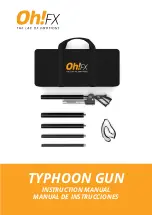
ENGLISH
43
Loss of control
Never perform jumps beyond your ability. This increases the risk of personal injury. You could land
on the frame or springs, or fall off the trampoline, if you lose control of the jump. A controlled jump
means that you jump up and land at the same place. If you lose control on the trampoline, stop by
bending your knees when you land on the bounce mat.
Somersaults
Never do somersaults in any direction (backwards or forwards) on the trampoline. You risk landing
on your head or neck
,
which can lead to paralysis and/or death
.
Foreign objects
Do not use the trampoline if there are pets, people or objects under it. This increases the risk of
personal injury.
Never hold any object in your hands when jumping and do not allow objects to lie on the trampoline
when someone is on it.
Make sure there are no obstacles above the trampoline, such as branches or cables etc., because
this increases the risk of personal injury
.
Inadequate maintenance
A trampoline in poor condition increases the risk of personal injury. Before using the trampoline
always check to see if any of the steel tubes are bent, for wear on the bounce mat, broken springs
and its general stability
.
Weather conditions
The trampoline must not be used in the rain or wind. A wet bounce mat increases the risk of
slipping.
A strong wind can cause you to loose control.
Restriction of access
When the trampoline is not in use, store the trampoline ladder in a safe place so that children
cannot play on the trampoline
.
Reducing the risk of accidents
The jumper
The most important thing is to be able to control your jumps. Never try to perform jumps beyond
your ability.
Practise basic jumping techniques until you can master them completely.
Read all the safety instructions and warning texts carefully, and practice safe jumping techniques
before use. A controlled jump means that you jump up and land at the same place.
.
You can get
further information on safe jumping techniques from a trampoline club
.
The supervisor
The person who supervises the jumping must understand and follow the safety instructions and
safety information.
The supervisor is responsible to provide information and guidance to those who are jumping.
When no one can supervise the jumping the trampoline must be stored in a safe place, preferably
dismantled, to avoid unauthorised use or covered with a heavy-duty tarpaulin which can be
securely fastened.
The supervisor is also responsible to ensure that the safety sign is fastened to the trampoline and
that users are aware of the information on the sign
.
ASSEMBLY
Positioning
There must be a free headroom of at least 7.5 metres above the trampoline.
Make sure there is free space around the trampoline.
Make sure there are no branches, swings, swimming pools, or electric cables nearby and place the
trampoline at a safe distance from walls and fences etc. Take the following into consideration when
positioning the trampoline.











































